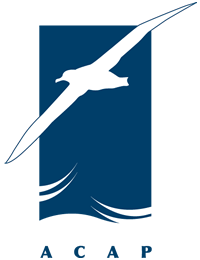During the 2010/011 breeding season for Black-browed Thalassarche melanophris and Grey-headed T. chrysostoma Albatrosses at the Diego Ramírez Islands, southern Chile, Cristián G. Suazo from the Universidad Austral de Chile (Institute of Ecology and Evolution) is carrying-out integrated studies on these globally Endangered and Vulnerable species.
Cristián has focused his work on gaining a better understanding of the contributing factors related to the condition of individual birds. Factors under consideration include adult health (e.g. chronic stress, parasite load, anti-oxidant levels), breeding habitat selection, environmental factors such as regional oceanographic and climatic variability plus the potential effects related to fisheries in important foraging ranges. His field collaborator during this breeding season was Jaime A. Cursach from Universidad de Los Lagos (Laboratorio de Ecología - Laboratory of Ecology), Chile.
This study is carried out thanks to support of researchers from the British Antarctic Survey, San José State University (USA), Australian Antarctic Division, Pacific Seabird Group, Centro Nacional Patagónico CENPAT (National Patagonic Center-Argentina), Museo Nacional de Ciencias Naturales de Madrid (National Sciences Museum - Spain), Max-Planck Institute für Ornithologie (Germany), Albatross Task Force (Chile), Centro de Investigación en Ecosistemas de la Patagonia CIEP (Patagonic Ecosystems Research Center - Chile) and American Bird Conservancy (Seabird Program). Also, this research was supported by Dirección de Investigación y Desarrollo (Direction of Investigation and Development - Universidad Austral de Chile) and CONICYT - Chile.
This study includes a second four- to five-month period of fieldwork during the 2011/12 breeding season to complement the current season. During fieldwork activities include the banding of breeding adult birds, the first-ever banding of pre-fledging albatrosses in Chile and the use of spatial tracking technologies to monitor adult birds and the first attempts to identify juvenile dispersion.
For further details please contact Cristián G. Suazo, Universidad Austral de Chile,
Information taken with thanks from the Pacific Seabird Group web site (www.pacificseabirdgroup.org).
John Cooper, ACAP Information Officer (on Marion Island), 27 April 2011

 Español
Español  English
English  Français
Français